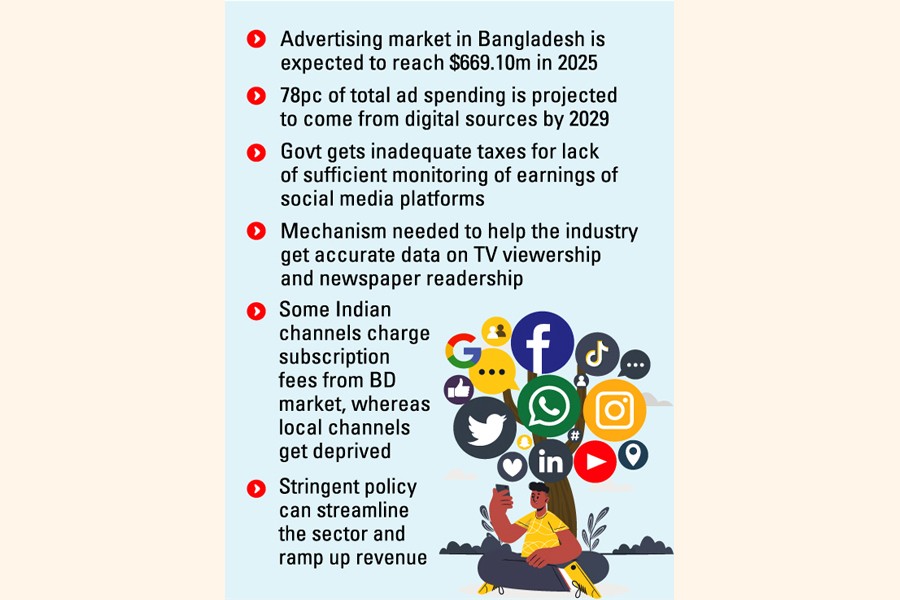The advertising market in Bangladesh is experiencing a significant shift towards digital media, with social media platforms rapidly gaining dominance over traditional media, industry insiders report.
Platforms like Facebook, Google, YouTube, and Netflix now hold nearly one-third of the country’s advertising market, valued at approximately Tk 40 billion annually. Meanwhile, traditional media outlets—including television channels, newspapers, and online portals—are struggling to maintain their share.
According to Morshed Alam, Managing Director of Asiatic Mindshare Ltd, digital advertising has been growing at a rate of 15-20% per year since the COVID-19 pandemic in 2020. In contrast, local television channels are losing 2-3% of their market share annually, while newspapers and online media outlets are experiencing an even sharper decline of about 10% per year.
Despite this shift, television still holds the largest share of the advertising market, accounting for nearly 50% of total ad spending. Industry estimates suggest that 36% of advertising expenses are directly managed by in-house advertisers, while multinational and local corporations continue to work with agencies for media planning and execution.
Statista Market Insights predicts that Bangladesh’s advertising market will reach $669.10 million in 2025, with digital sources expected to account for 78% of total ad spending by 2029. This transition highlights the growing demand for targeted online campaigns aimed at tech-savvy consumers.
Challenges in the Digital Advertising Landscape
The rise of social media advertising has raised concerns over revenue loss for the government, as many digital platforms operate in Bangladesh without local offices, limiting tax and VAT collection. Additionally, Bangladeshi content creators earn significantly less than their counterparts in neighboring countries like India due to the absence of direct negotiations with social media companies.
Advertising agencies in Bangladesh must make payments to social media platforms in foreign currencies while receiving payments from local clients in Bangladeshi Taka. This creates financial complications and impacts revenue streams for local advertisers.
“If these platforms had offices in Bangladesh, the government could generate substantial tax revenue, reduce ad costs, and support local content creators,” said Morshed Alam. He pointed out that social media giants have established offices in many countries, including India, but not in Bangladesh.
Advertisers Favor Digital Due to Targeted Reach
The increasing number of internet users has made social media advertising more attractive. With advertising options available from as low as $50, businesses can reach targeted audiences efficiently. Nazim Farhan Choudhury, Managing Director of Adcomm Ltd, noted that advertisers prefer social media platforms because they provide real-time engagement and audience insights—capabilities that traditional media lack.
“Unlike television or print media, social media allows direct interaction with the audience, providing valuable feedback for advertisers,” he added.
Decline of Traditional Media and the Need for Reform
The lack of reliable data on television viewership and newspaper circulation further hampers advertising prospects for traditional media. Industry experts emphasize the need for a structured system to track media reach, suggesting initiatives like an audit bureau for circulation and a subscription model for TV channels.
Despite declining ad revenues, many television channels and newspapers are adapting by expanding their presence on social media platforms. However, Ebne Hasan Khan, Director of Marketing and Sales at Channel i, warns that the local TV industry remains at a disadvantage compared to international channels that benefit from subscription revenue.
“Bangladesh’s advertising market isn’t large enough to sustain 40 TV channels solely through ad revenue. A subscription model could provide financial stability,” he stated.
Impact on the Film Industry
The shift to digital platforms is also affecting Bangladesh’s film industry. Although the country has a rich cinematic history, only a handful of films—such as Eti Tomar E Dhaka, Komola Rocket, and Pipra Bidya—have made it onto Netflix. Industry insiders argue that if platforms like Netflix had local offices, Bangladeshi films would gain better global exposure.
Future of the Newspaper Industry
Newspaper readership has been in decline since the COVID-19 pandemic, with circulation failing to return to pre-pandemic levels. Many readers now consume news online, forcing newspapers to rethink their business models.
“The private sector’s ad spending on print media is shrinking. To survive, newspapers must embrace digital platforms and leverage social media effectively,” said a senior advertising executive, speaking on condition of anonymity.
Leading Advertising Agencies in Bangladesh
Major players in the advertising and communications industry include GroupM (operating under Asiatic 3Sixty), Mediacom Ltd, Adcomm Ltd, Starcom Bangladesh, and Top of Mind. These agencies cater to both local and multinational clients, adapting to the evolving digital landscape.
As Bangladesh’s ad market continues to transition towards digital, experts emphasize the need for regulatory frameworks to ensure fair competition, better tax compliance, and sustainable growth for both traditional and digital media sectors.


